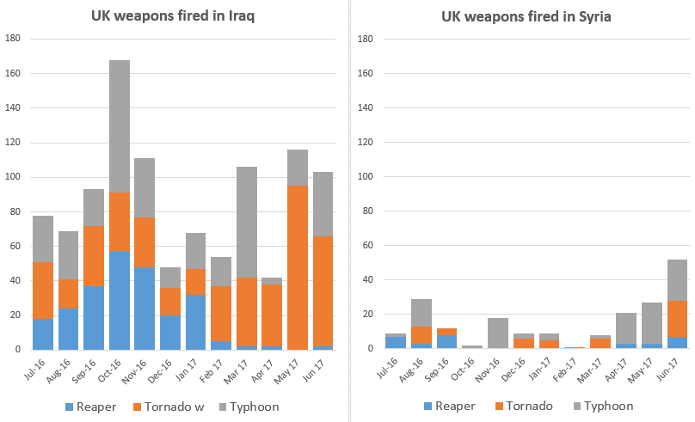
However, rather surprisingly in the light of the huge increase in missions in Syria, the vast majority of UK air strikes continues to occur in Iraq, with 81% of UK missile and bombs dropped there in the first half of the year (see table below). Responses to our queries about this appear to indicate that this is due to UK aircraft deployed on missions inside Syria not launching their weapons there, but in Iraq on their return journey. UK weapons fired in Syria did increase by almost 50% from 79 in last six months of 2016 to 118 in first half of 2017.


UK armed drones in Iraq and Syria
Figures show that the focus of UK Reaper drone operations also switched from Iraq to Syria in the first six month of 2017. From January to June 2017 there were just 84 Reaper missions in Iraq, a sharp decline from the 226 that had occurred there during the previous six months. Across the border in Syria, RAF Reaper missions rose from 88 in the final six months of 2016 to 254 in the first half of 2017.
The number of weapons fired from UK drones in Iraq declined alongside the reduction in the number of missions there, with UK drones launching just 43 weapons in first six months of 2017 compared to 204 in the previous six months. In Syria, however, despite a 280% increase in reaper missions there, the number of weapons launched by UK drones remained roughly the same with 5 Reaper ‘strikes’ (launching 13 weapons) in the first half of 2017 compared to 8 ‘strikes’ (launching 18 weapons) in Syria in the previous 6 months.
It appears that alongside the switch of focus from Iraq to Syria, there has also been a change in the way UK Reapers are being used. We know from previous FoI responses that the vast majority of British strikes are undertaken using dynamic targeting procedures. That is, instead of being sent to undertake a pre-planned strike on a specific target, the vast majority of British armed air missions are to fly to a certain location to undertake surveillance, look for targets of opportunity or in support of Iraqi ground forces.
In the last six months of 2016 for example, UK Reapers flew 226 missions in Iraq during which they launched 204 weapons. From the the MoD’s Operation Shader updates page we can see that these occur when Reapers, undertaking surveillance mission or in support of ground troops, spot a target and launch a strike.
However in the first six months of 2017, while undertaking more than 250 such missions in Syria, British Reapers only launched 13 weapons. By coincidence, the UK’s Typhoon aircraft have flow exactly the same number of missions in Syria in the same six month time frame and launched more than five times the amount of weapons (although it should be remembered that a Typhoon missions consists of two aircraft while a Reaper missions consists of just one Reaper).
SafeSubcribe/Instant Unsubscribe - One Email, Every Sunday Morning - So You Miss Nothing - That's It

NOTE – UK reporting issues continue
The smaller number of UK Reaper strikes over the past few months enables a much clearer demonstration of the difficulties of tracking UK air strikes. and the need for increased transparency. Alongside FoI statistics detailing air operations in Iraq and Syria, the MoD publishes regular updates describing UK air operations against ISIS. The table below compares figures given for UK Reaper strikes in response to our FoI requests with the MoD’s narrative of UK air operations.
Of the four months from March – June 17 only two months (March and May) give matching data . However in April, FoI figures report two UK Reaper strikes against ISIS, but only one is detailed in the MoD’s narrative. On the other hand, the FoI response reports three UK Reaper strikes against ISIS in June 2017, while the MoD update in fact details five such strikes.
While both data sets are important sources of information, the fact that such crucial details differ can undermines confidence in the MoD’s reporting.
As always, for more on Coalition air strikes in Iraq and Syria, and especially on civilian casualties, see the Airwars website.





